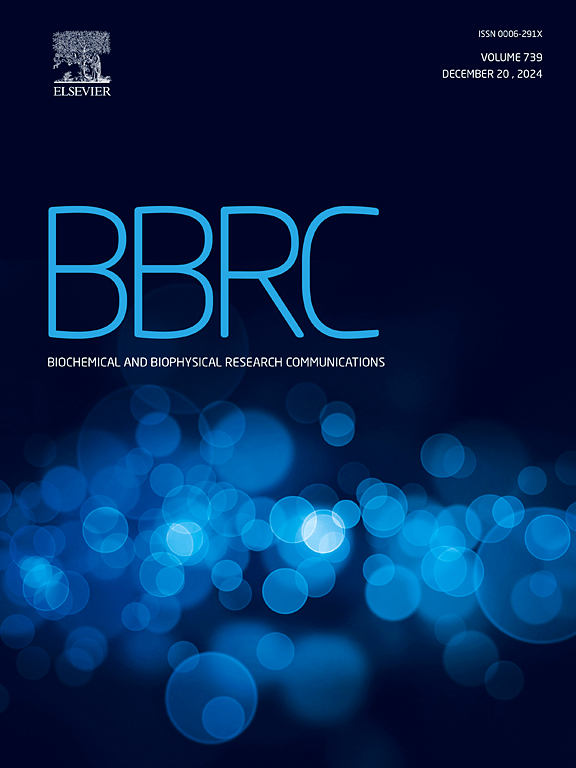Molecular basis of the therapeutic effect of butyrate in glioblastoma revealed by in vitro and in silico approach
IF 2.5
3区 生物学
Q3 BIOCHEMISTRY & MOLECULAR BIOLOGY
Biochemical and biophysical research communications
Pub Date : 2025-06-19
DOI:10.1016/j.bbrc.2025.152216
引用次数: 0
Abstract
Glioblastoma (GBM) remains among the most difficult to treat cancers globally. Complexity of this disease and the existing inadequacies of modern therapy put forward the need for ongoing research into new therapies. Short Chain Fatty Acids (SCFAs) are among the major metabolites secreted by the gut microbiome, and are thought to play an important role in gut microbiome-brain interactions. While earlier experimental studies have hinted towards a therapeutic potential of butyrate in glioblastoma, we demonstrate here the molecular mechanism behind this effect through a combination of in vitro and in silico approaches. LN229 and U87 GBM cells were treated with butyrate, and anti-proliferative potential was evaluated through colony formation assay, flow cytometry and qRT-PCR experiments. Molecular mechanism was mapped through butyrate target prediction, molecular docking, molecular dynamics simulations and analyses of binding free energy calculations. Butyrate inhibited the proliferation, and colony formation in U87 and LN229 GBM cell lines. We also found that it arrested the cell cycle progression at the G0/G1 phase in U87 cells and the G2/M Phase in LN229 cell lines, along with initiation of apoptosis in both the cells. Similarly, butyrate treatment also reduced the expression of Epidermal Growth Factor Receptor (EGFR) in a dose-dependent manner. The molecular mechanism behind the anti-cancer effect of butyrate was demonstrated through molecular docking and simulation studies. Butyrate bound to Histone Deacetylase-3 (HDAC3)-Nuclear CoRepressor2 complex, and induced allosteric dynamics that further blocked HDAC3 activation. The observations in this study demonstrate the potential of butyrate as a viable therapeutic agent for glioblastoma.
体外和计算机方法揭示丁酸酯治疗胶质母细胞瘤疗效的分子基础
胶质母细胞瘤(GBM)仍然是全球最难治疗的癌症之一。这种疾病的复杂性和现有的现代治疗的不足,提出了需要不断研究新的治疗方法。短链脂肪酸(SCFAs)是肠道微生物群分泌的主要代谢物之一,被认为在肠道微生物群与大脑的相互作用中起重要作用。虽然早期的实验研究暗示了丁酸盐在胶质母细胞瘤中的治疗潜力,但我们在这里通过体外和计算机方法的结合证明了这种作用背后的分子机制。用丁酸盐处理LN229和U87 GBM细胞,通过集落形成实验、流式细胞术和qRT-PCR实验评估其抗增殖能力。通过丁酸盐靶点预测、分子对接、分子动力学模拟和结合自由能计算分析,绘制了分子机理图。丁酸盐抑制了U87和LN229 GBM细胞株的增殖和集落形成。我们还发现,它在U87细胞和LN229细胞系中阻滞了细胞周期在G0/G1期和G2/M期的进展,并在这两种细胞中启动了凋亡。同样,丁酸盐处理也以剂量依赖的方式降低了表皮生长因子受体(EGFR)的表达。通过分子对接和模拟研究,揭示了丁酸酯抗癌作用的分子机制。丁酸盐结合组蛋白去乙酰酶-3 (HDAC3)-核辅酶抑制复合物,诱导变构动力学,进一步阻断HDAC3的激活。本研究的观察结果表明丁酸盐作为胶质母细胞瘤可行的治疗剂的潜力。
本文章由计算机程序翻译,如有差异,请以英文原文为准。
求助全文
约1分钟内获得全文
求助全文
来源期刊
CiteScore
6.10
自引率
0.00%
发文量
1400
审稿时长
14 days
期刊介绍:
Biochemical and Biophysical Research Communications is the premier international journal devoted to the very rapid dissemination of timely and significant experimental results in diverse fields of biological research. The development of the "Breakthroughs and Views" section brings the minireview format to the journal, and issues often contain collections of special interest manuscripts. BBRC is published weekly (52 issues/year).Research Areas now include: Biochemistry; biophysics; cell biology; developmental biology; immunology
; molecular biology; neurobiology; plant biology and proteomics

 求助内容:
求助内容: 应助结果提醒方式:
应助结果提醒方式:


